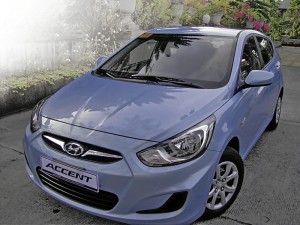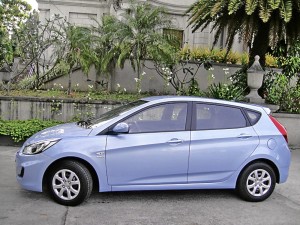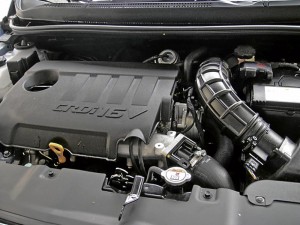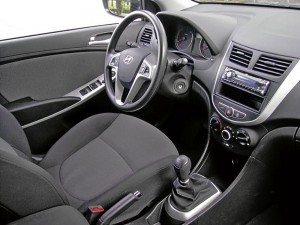Hyundai’s punchy little diesel hatchback
When motoring journalists from seven countries including the Philippines tested the all-new, fluidic-sculptured subcompact Hyundai Accent in Dubai in February 2011, many of us asked when a diesel version would be offered in our country. Evasive answers didn’t give us much hope.
But suddenly last month, Hyundai Asia Resources Inc. (Hari), the Philippine distributor of Hyundai vehicles and parts, announced that the fourth-generation 1.6-liter CRDi (common rail direct injection), VGT (variable geometry turbo) intercooler diesel Accent is here. And in a sporty hatchback form at that, making the new arrival from South Korea’s biggest carmaker the first and only diesel-powered 5-door subcompact hatch on the Philippine market.
There are several reasons why many car buyers choose diesel over gasoline-fed vehicles, the primary one being the lower retail price of diesel fuel. In this country, diesel fuel costs some five pesos less per liter than unleaded gasoline. Moreover, diesel engines have proven to be stronger and more durable. Cutting-edge CRDi technology has eliminated much of the clattering, noise and harshness associated with diesel engines. Driving or riding a CRDi vehicle these days is such a smooth, comfortable and quiet experience that you sometimes think you’re in a gasoline-powered car.
However, given the high sulfur content and low quality of the diesel fuel sold by the oil majors here, the smelly, noxious fumes emitted are still a problem—but that’s another story.
AFFORDABLE. Aside from its CRDi powertrain, the Accent hatch lures with its affordable retail price. The 6-speed manual transmission model with 14-inch steel rims and driver’s side airbag is yours for P768,000 while the 4-speed automatic transmission model with 16-inch alloy wheels, dual airbags, electric-heated side mirrors, leather-wrapped steering wheel and front fog lamps cost P868,000.
Article continues after this advertisementBoth variants have as standard equipment a rear spoiler, motor-driven power steering, disc brakes front and rear, ABS with electronic brake force distribution, keyless entry with alarm, audio controls on the tilt-adjustable steering wheel, 60/40 split folding rear seat, central door locks, power windows and side mirrors, a 4-speaker audio system with tuner, single CD player, MP3, USB port, AUX-in and Bluetooth, a trip computer, ECO Mode and manual air conditioner. The suspension system consists of McPherson strut with coil spring in front and coupled torsion beam axle at the rear.
Article continues after this advertisementCar buffs may ask: Why is the automatic tranny an outmoded 4-speed instead of 6-speed; why is there no cruise control, no stop-start push button, no rear parking sensors or rear camera, no tweeters for the audio system, no leather seats, no HID headlights, no automatic climate control? Silly question: Those nice things are missing to keep the price of the car down. Maybe Hari can offer them as options. Remember that the preceding stripped-down diesel Accent sedan was being marketed to taxicab operators.
UPSWEPT. But it would be sad if the Accent CRDi hatchback with its upswept beltline and hexagonal grille were to be seen on the road mainly as taxicabs. The 1.6-liter, 16-valve CRDi VGT engine producing 128 HP/4,000 rpm and 260 Nm/1,900-2,750 rpm max torque is the same engine that powers the much more expensive Hyundai i30 hatch. Fuel consumption in both city and highway driving average 22 km/liter for the manual transmission (MT) model, which I test-drove, while the automatic transmission (AT) variant averages 17.85 km/liter, according to the Hyundai Motor Co.
The Accent CRDi hatch is easy to drive, surprisingly smooth and quiet for a diesel subcompact, with the 6-speed MT gearbox shifting accurately. The punchy CRDi VGT engine delivers strong pulling power with 260 Nm of torque all the way from 1,900 to 2,750 rpm and responds best starting from about 1,500 rpm. The fifth and sixth gears are highly geared for economy, so downshifting is required when driving a steep uphill climb. In sixth gear doing 110 kph, it barely hits 2,000 rpm.
The hatchback handles well, exhibiting less body roll, more grip in corners and good road manners. Yet it is not overly sporty. The CRDi powertrain and high gearing make the Accent
hatch suitable for city driving as well as high-speed highway cruising. In the city, the Accent hatch is small and nimble enough to maneuver easily, but reversing into a parking slot is a bit dicey due to the tall backseat and small rear window.
EASY ON THE EYE. Inside, the Y-shaped dashboard design is easy on the eye and logical, with faux metallic splashes to lighten up the matte black center fascia. The height-adjustable driver’s seat is comfy and supportive, ditto the front seat, but the rear seat is tight for tall passengers whose knees would likely press into the backs of the front seats.
While the cockpit has door pockets incorporating bottle holders and two cupholders between the front seats, storage space is limited in the rear with no pockets in the rear doors. The rear seat splits 60/40 and folds flat with a one-touch action to increase cargo room which measures 21.2 cubic feet when the rear seat is up. The trunk is easy to load and has a security cover.
Bottom line, the Accent CRDi hatchback is a good-looking subcompact offering strong performance, nice handling, a smooth, quiet and comfy ride, and outstanding fuel economy at an affordable price. It may be a bit less refined than a gasoline-fed car and lack some of the features found as standard equipment in competing subcompact cars, but they don’t have Hyundai’s class-leading CRDi VGT technology. A bit of unsolicited advice: Get the 6-speed MT hatch—it not only costs less and sips less fuel, it’s more fun to drive.



